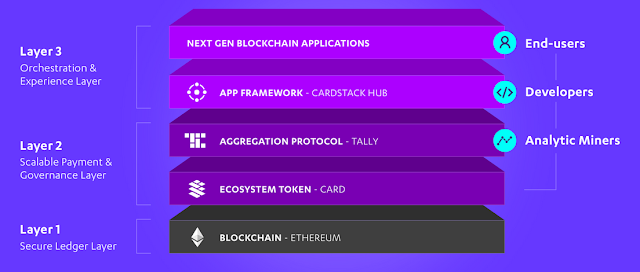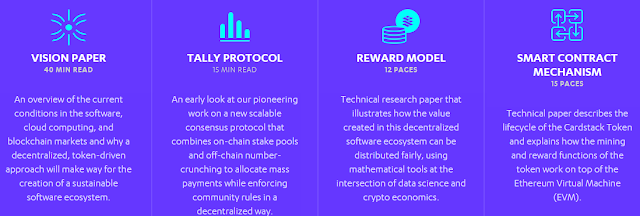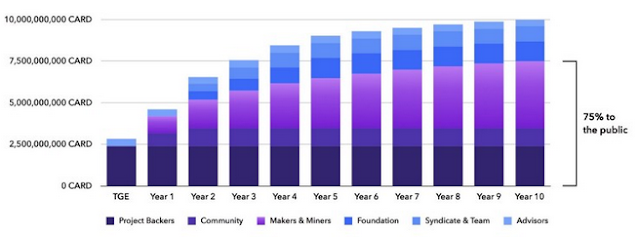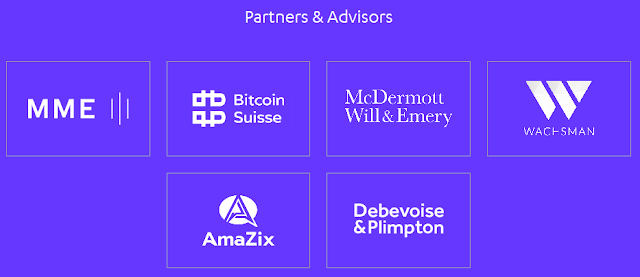CardStack - The experience layer of the decentralized Internet.
A cryptocurrency is a digital asset designed to work as a medium of exchange that uses cryptography to secure its transactions, to control the creation of additional units, and to verify the transfer of assets. Cryptocurrencies are a form of digital currencies, alternative currencies and virtual currencies. Cryptocurrencies use decentralized control as opposed to centralized electronic money and central banking systems.
Cryptocurrency exchanges or digital currency exchanges (DCE) are businesses that allow customers to trade cryptocurrencies or digital currencies for other assets, such as conventional fiat money, or different digital currencies. They can be market makers that typically take the bid/ask spreads as transaction commissions for their services or simply charge fees as a matching platform.
Introducing Cardstack
Cardstack is the experience layer of the decentralized Internet. They believe that orchestrating cohesive user experiences across the blockchain and the cloud is essential to bringing decentralization to the mass market. They propose a new economic model for funding and sustaining the software that runs the world, in a way that distributes rewards fairly among the creators of the software and the open-source communities supporting them. In this decentralized software market, a buyer of applications enters into a direct deal via smart contracts, which coordinate a diverse network of software development teams, cloud hosting providers, and app coin-backed protocols.
Cardstack Mission
Our mission is to build an economically sustainable software ecosystem that fights back against the rampant lock-in mechanisms of centralized platforms.
Cardstack is a revolutionary experience layer that makes blockchain technology usable and scalable — creating a decentralized software ecosystem that can challenge today’s digital superpowers.
Centralized tech giants force us into silos, and capture the value we create. Early decentralized tech like Bitcoin demonstrates the promise of blockchain, but has only delivered gains to a handful of enthusiasts. Cardstack is a leap forward for blockchain at every layer of the software stack — providing a toolset that unlocks the potential of the decentralized Internet for everyone.
Cardstack want to break down app silos in favor of an open digital world. With Cardstack, end-users can mix and match features from multiple apps or dApps without worrying about a mess of separate cloud subscriptions or utility tokens. What’s even more exciting: our system lets users design incredible new workflows — joining services from different layers of the Internet — that simply wouldn’t have been possible in a centralized world.
This breakthrough is made possible by Cardstack’s composable design paradigm, which renders units of information as bite-sized, encapsulated cards, which can be expanded, embedded, attached, chained, triggered, versioned, cloned, approved, rescinded — or saved forever. In a decentralized world, your data should be as networked or as sovereign as you want.
Developers can use the Cardstack Framework, a comprehensive SDK, to create powerful, card-based blockchain apps. Build anything using modular narrative and discovery containers. Easily construct custom workflows using our Cardstack Hub, which orchestrates data and value transfer across multiple blockchains and the cloud. Drop in ready-to-use functionality like searchable indexes, real-time notifications, uniform user permissions, flexible containerized deployment, and much more. Everything is extensible, and is 100% open-sourced.
Cardstack Concepts
Centering the Internet Around the User - The new approach to orchestration must put the users at the center and let them act as their own hub, so that interactions with applications and services flow through a software stack controlled by the users.
Turning Services into Tangible “Cards” - The necessary orchestration can be made intuitive by turning each state of an application into a “card”, which is a visual embodiment of the key information, suggesting the next course of action via chaining of related cards.
Bridging Blockchain and Cloud Services - These “cards” become the primary unit of interaction between the users and many variants of competing services, which run locally, in the cloud, or on a blockchain and fulfill the different aspects of users’ needs.
Enabling Progressive Decentralization - Behind the facade of cards, the process of decentralizing the software ecosystem can be done piecemeal, allowing for drop-in replacement of common cloud services when blockchains are ready to act as substitutes.
This ecosystem is governed by smart contracts powered by the Cardstack Token (CARD), an Ethereum-based ERC20 token. CARD isn’t just any old cryptocurrency: it’s designed specifically to create a sustainable marketplace where open-source developers are rewarded fairly, while allowing users to curate and combine the perfect mix of software services to fit their needs.
Here’s how it works. When a user spends CARD, it seamlessly forms smart contracts between the user and their chosen apps, before getting staked into a reward pool. Based on anonymized usage data tracked by the smart contracts, the pooled tokens are then periodically distributed to the apps’ creators and contributors according to a decentralized algorithmic payment and governance model that rests in the hands of the community.
Just like other cryptocurrencies, CARD users can become miners to validate transactions and earn fees. But unlike Bitcoin — which forces miners to solve useless math problems — Cardstack analytic miners help calculate the reward function of who gets paid out what, while sifting out spam, making the system fair and resilient. Analytic miners’ results compete in a sortition scheme we call proof-of-analytics, so reward algorithms are never under a single party’s control.
Foundational Documents
To help you gain a deeper understanding of the market context, mathematical model, and token mechanisms behind Cardstack project, our team has prepared 4 additional papers for your review:
Technology
Cardstack is a leap forward for blockchain at every layer of the software stack — providing a toolset that unlocks the potential of the decentralized Internet for everyone.
ICO DETAILS
Smart contracts, Cardstack Token and Token software and services
Smart contracts in ecosystems Cardstack upgradable via the registry and this abstraction directing transactions to the latest version. Cardstack tokens that are written as a CST and also just referred to as “the card”. Cardstack token is a token traded based on standards of the ERC-20 Ethereum network. Software and services transferable token entry in each application of the contract.
Software and services token serves as a store credit can be redeemed within a certain period by the user. SSC is cut and burned as the use of the meter. If the CST converted to SSC, they locked in prize pool and distributed to the contributors on the model of multi variables.
Token Mechanisms
Our ecosystem is governed by smart contracts powered by the Cardstack Token (CARD). With this single token, users can pay for their entire mix of software usage, verified by our off-chain consensus protocol. The result is a seamless experience for consumers, and fair rewards for makers and miners.
Introducing Cardstack Token
Cardstack Token is the fuel and catalyst for the global movement towards a sustainable software market built on open-source code and powered by crypto-economics. Cardstack Foundation is pleased to announce the allocation process and the token metrics for its upcoming Token Generation Event (TGE). The Switzerland-based Cardstack Foundation will initiate a fundraiser, followed by a series of airdropped awards, so as to distribute tokens to interested participants of the Cardstack ecosystem.
Cardstack’s Token Generation Event is designed to balance the interests of multiple stakeholders so as to achieve these goals:
Optimize the token allocation so that the three main participant groups in the Cardstack ecosystem — end-users, software makers, and analytic miners — have access to the right proportion of tokens at each stage of the growth of the ecosystem to maximize utility.
Ensure regulatory compliance to all applicable laws and regulations, so the TGE can be conducted in an orderly fashion, as well as to minimize risks for the contributors as well as for the Foundation.
Reward community members, especially those who joined Cardstack early in its growth phase, with a clear and fair process for participation regardless of the level of individual contributions.
Cardstack Token Sale
Cardstack Tokens and Smart Contracts - The initial implementation of the Cardstack token mechanism is written in Solidity and is currently on the Ethereum testnet. They have open-sourced all 20+ smart contracts via GitHub.
Cardstack Token (CST) - This is the tradable token based on the ERC20 standard of the Ethereum network. When CST are converted into SSC, they are locked in a reward pool and distributed to contributors based on a multi-variable model.
Software and Services Token (SSC) - SSC are non-transferable entries in each of the application contracts. They act like a store credit that can be redeemed by a user within a specific period of time (e.g. 1 year). As usage is metered, SSC are deducted and burned.
Token Information
- Name: Cardstack Token
- Symbol: CARD
- Token Type: ERC20 on Ethereum
- Jurisdiction: Zug, Switzerland
- Hard cap: $35,000,000 in USD
- Soft cap: $10,000,000 in USD
- Token Created at TGE: 6,000,000,000 CARD
- Token Available for Public at TGE: 2,400,000,000 CARD (40%)
- Bonus for Pre-Allocation: 10%
- KYC/AML: Yes
- TGE Date: Q1 2018 (projected)
- Method of Contribution: ETH
- Whitelisting of Ethereum Address: Required for crowd fundraiser
- Individual Caps: Enforced by smart contract during crowd fundraiser
- Vesting Schedule: Foundation (5 years) Syndicate & Team (4 years), Ecosystem Initiatives (2 years)
- Inflation / Mining Function: Additional 4,000,000,000 tokens distributed over 10 years to bootstrap reward pools for software makers and analytic miners
- Maximum Number of Tokens: 10,000,000,000 CARD in 2028
- Excludes Contributors From: United States, Cuba, Iran, North Korea
Token Distribution Phases
The Foundation will distribute 40% of the total of Cardstack Tokens (CARD) that will be generated at the Token Generation Event (TGE) to the public. These tokens will be distributed through a series of batches to ensure a fair allocation to our community of contributors, while maintaining compliance to applicable laws and regulations.
You are interested?
let's join Cardstack .. !!!
Partners & Advisors They
For more details, please visit in under here's:
Website: https://cardstack.com/
Medium:https://medium.com/cardstack
Twitter:https://twitter.com/cardstack
Facebook:https://facebook.com/cardstackproject
ANN:https://bitcointalk.org/index.php?topic=2805234.new#new
Whitepaper:https://cardstack.com/whitepaper-pdf
Telegram:https://telegram.me/cardstack
Github:https://github.com/cardstack/cardstack
Author: Supertar
My profil: https://bitcointalk.org/index.php?action=profile;u=1859198







